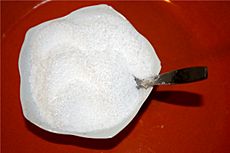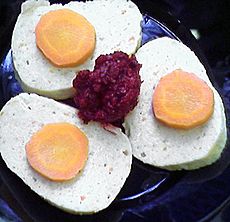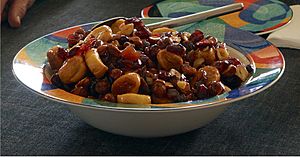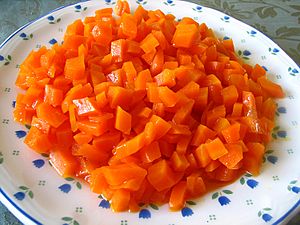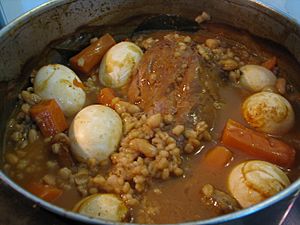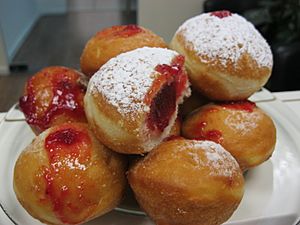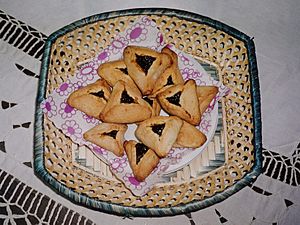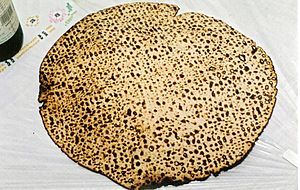Jewish cuisine facts for kids
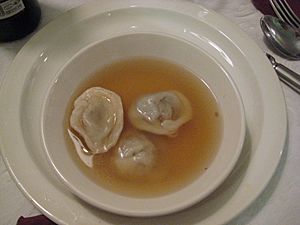
Jewish cuisine is all about the cooking traditions of Jewish people around the world. It has grown and changed over many centuries. This food is shaped by Jewish dietary laws, called kashrut, and by special Jewish festivals and Shabbat (Sabbath) traditions. Jewish food is also influenced by the places where Jewish communities have lived, like their economy, farming, and local cooking styles. This means Jewish food looks very different in various parts of the world!
The story of Jewish cuisine starts with the ancient Israelites. As Jewish people spread out across the world (this is called the Jewish diaspora), different ways of cooking developed. The main styles of Jewish cooking include Ashkenazi, Sephardi, Mizrahi, Persian, Yemenite, Indian, and Latin American. There are also unique dishes from Jewish communities in places like Ethiopia and Central Asia.
Since the country of Israel was created in 1948, especially from the late 1970s, a new kind of Israeli "fusion cuisine" has appeared. Israeli cuisine combines many cooking ideas, methods, and ingredients from different Jewish communities around the world. It also uses local Middle Eastern dishes from non-Jewish people in Israel. This makes Israeli Jewish cuisine truly Jewish and kosher, but also very unique to Israel, blending many cultures.
Contents
Influences on Jewish Cooking
What is Kashrut? Jewish Food Rules
The rules of keeping kosher (kashrut) have really shaped Jewish cooking. These rules tell people what foods they can eat and how to prepare them. The word kosher usually means "proper" or "fit."
Some foods are completely forbidden, like pork and shellfish. Also, meat and dairy products cannot be mixed together. Meat must be ritually slaughtered and salted to remove all traces of blood.
Jews who follow these rules strictly will only eat meat or poultry that is certified kosher. The animal must be slaughtered by a shochet (a special ritual slaughterer) according to Jewish law. All blood must be drained from the meat. Before cooking, the meat is soaked in water for 30 minutes. Then, it's placed on a special board, sprinkled with coarse salt to draw out the blood, and left for one hour. After that, the salt is washed off, and the meat is ready to cook.
Today, if you buy kosher meat from a butcher or supermarket, it's usually already prepared this way. So, you don't need to soak or salt it again.
Because of kashrut, meat and poultry cannot be mixed with dairy products. They also can't touch plates or utensils that have touched dairy. So, very observant Jews often have separate kitchen areas for meat and dairy, with different ovens, plates, and cooking tools.
This means that butter, milk, and cream are not used when preparing meat dishes or meals served with meat. Instead, cooks use oil, pareve margarine (which has no meat or dairy), rendered chicken fat (called schmaltz by Ashkenazi Jews), or non-dairy cream substitutes.
How Geography Changed Jewish Food
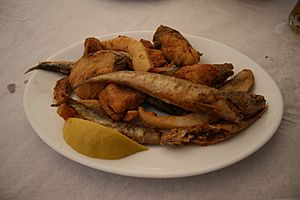
The hearty food of Ashkenazi Jews developed over centuries in the cold climate of Central and Eastern Europe. In contrast, the lighter, "sunnier" food of Sephardi Jews was influenced by life in the Mediterranean region.
Each Jewish community has its own traditional dishes, often using ingredients from their home country. In Spain and Portugal, olives are a common ingredient, and many foods are fried in oil. For example, the idea of frying fish, which is famous in British fish and chips, was brought to Britain by Sephardic Jewish immigrants. In Germany, stews were popular. Jews in the Netherlands were known for pickles, herring, butter cakes, and bolas (jamrolls). In Poland, Jews made various kinds of stuffed and stewed fish, along with matza ball soup or lokshen noodles. In North Africa, Jews ate couscous and tagine.
So, a traditional Shabbat meal for Ashkenazi Jews might include stuffed vine leaves, roast beef or chicken, carrots tzimmes, and potatoes. A traditional Shabbat meal for Sephardi Jews would focus more on salads, couscous, and other Middle Eastern dishes.
History of Jewish Cooking
Ancient Times: Biblical Era Food
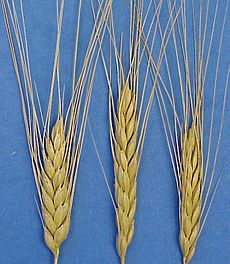
The everyday diet of ancient Israelites was mostly bread, cooked grains, and beans. Bread was eaten with every meal. Until the time of the Israelite kings, most bread was made from barley flour.
Later, during the Second Temple period, bread made from wheat flour became more common. There were different kinds of bread. Flat, unleavened loaves called ugah or kikkar were probably most common. A thinner wafer was called a rakik. A thicker loaf, hallah, was made with the best flour, often for religious purposes. Sometimes, flour from beans was added to bread (Ezekiel 4:9).
The Mishna (an ancient Jewish text) mentions bread dough made with fruit juice instead of water to make it sweet. Israelites sometimes added fennel and cumin for flavor. They also dipped their bread in vinegar (Ruth 2:14), olive oil, or sesame oil.
Vegetables were important but played a smaller role. Beans and vegetables were usually eaten in stews. Stews made of lentils or beans were common, cooked with onion, garlic, and leeks for flavor. Fresh beans were also roasted, or dried and stored, then cooked in soup or stew. Vegetables were also eaten raw with bread.
Israelites drank goat and sheep's milk when it was available in spring and summer. They also ate butter and cheese. They had honey from bees and date honey.
Figs and grapes were the most common fruits. Dates, pomegranates, almonds, and other fruits and nuts were eaten less often.
Wine was the most popular drink. Other fermented drinks were sometimes made too.
Meat, usually goat and mutton, was rarely eaten by most Israelites. It was saved for special times like celebrations, festivals, or religious feasts. Wealthy people ate meat more often, including beef, venison, and veal.
Olives were mainly used for their oil, which was eaten raw and used to cook meat and stews. Wild animals (like deer and gazelle), birds, eggs, and fish were also eaten, depending on what was available. Meat was usually prepared in broths or stews, and sometimes roasted. For long-term storage, meat was smoked, dried, or salted.
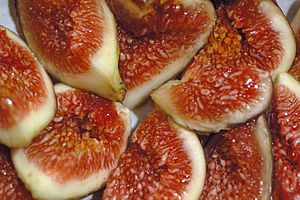
Porridge and gruel were made from ground grain, water, salt, and butter. This mixture also formed the base for cakes. Oil, called shemen, and fruits were sometimes added before baking.
Most food was eaten fresh and in season. Fruits and vegetables had to be eaten when ripe before they spoiled.
People often faced hunger and famine. Growing enough food required hard work and good timing. The weather in Israel led to unpredictable harvests, so people needed to store as much food as possible. Grapes were made into raisins and wine, olives into oil, figs, beans, and lentils were dried, and grains were stored for the year.
Fresh milk spoiled quickly, so Israelites stored milk in skin containers, which made it curdle fast. They drank it as thick, sour milk called laban.
The Bible describes typical Israelite meals. The Book of Samuel tells how Abigail brought David's group bread, wine, butchered sheep, parched grain, raisins, and fig cakes. The Book of Ruth describes a simple breakfast: bread dipped in vinegar and roasted grain.
Jewish food traditions continued to be important even after the Second Temple was destroyed in 70 CE and the Jewish diaspora began. Bread, wine, and olive oil were seen as direct links to the three main crops of ancient Israel: wheat, grapes, and olives. These three crops are mentioned in the Bible as a sign of God's care for human needs (Hosea 2:23-24 and Deuteronomy 11:13-14).
The importance of wine, bread, and oil is shown by their use in Jewish religious rituals. There are blessings over wine and bread for Shabbat and holiday meals. Olive oil is used for lighting Shabbat and festival candles.
Modern Jewish cooking is very different from what ancient Israelites ate. However, a few dishes from ancient Israel still exist today. One notable example is cholent, or hamin. This is a stew traditionally eaten on Shabbat, simmered for 12 hours to follow Shabbat rules. It dates back to at least the Second Temple period. Different Jewish communities created their own versions of this dish based on their local climate and ingredients. Other ancient foods include pastels (Shabbat meat pies) and charoset, a sweet fruit and nut paste eaten at the Passover Seder.
Middle Ages: New Foods and Traditions

During the Middle Ages, Jewish people were spread out so widely that it's hard to describe their food habits in one go. In Arabic countries, some Jewish foods were known, like paspag, which might have been a type of biscuit.
The well-known ḥaroset (a paste for Passover) was made in some countries from a mix of herbs, flour, and honey.
Maimonides, a famous Jewish scholar, wrote about healthy dishes. He suggested bread made from wheat that wasn't too new or too old. He also recommended meat from young goats, sheep, and chickens, and egg yolks. Goat's and cow's milk were good, and cheese and butter were not harmful. Honey was good for older people. Fish with solid white meat was healthy, as were wine and dried fruits. However, he didn't recommend fresh fruits, garlic, or onions.
Detailed information about Italian Jewish cooking comes from a book called Massechet Purim. It mentions pies, chestnuts, turtledoves, pancakes, small tarts, gingerbread, stews, venison, roast goose, chicken, stuffed pigeons, ducks, pheasants, partridges, quails, macaroons, and salad. These were considered luxury foods.
During the Middle Ages, many Jewish people faced hardship. They usually enjoyed large meals only on Shabbat, festivals, and at weddings. For example, Jews in Rhodes (according to a letter from 1488) ate only herbs and vegetables, rarely tasting meat or wine. In Egypt, however, meat, fish, and cheese were available. In Gaza, grapes, fruit, and wine were common. Cold dishes are still popular in the East. Generally, people ate only one dish with fresh bread daily.
Some Jewish dishes often mentioned in Yiddish literature from the 12th century onwards include brätzel, lokshen (noodles), pasteten (pastries), fladen (flatbreads), and beleg (toppings).
Barscht or borscht is a Ukrainian beet soup. The berkes or barches (challah bread) eaten on Shabbat are well-known. Shalet (cholent), a slow-cooked stew, is also famous. Shabbat pudding, kigl or kugel in Yiddish, is another popular dish.
Modern Era: Jewish Food Today
In the United States, Jewish cooking and cookbooks changed as the role of Jewish women and the Jewish home evolved.
Jewish cuisine has also greatly influenced restaurants in Western countries, especially the UK and US. Israeli cuisine has become a leading food trend in the UK, with many Israeli restaurants opening in London and beyond.
In the 1930s, Minneapolis had four Jewish bakeries close to each other, baking bagels and other fresh breads. Jewish families bought challah loaves for their Sabbath meal. There were two kosher meat markets and four Jewish delicatessens. One of these delis started distributing what would become Sara Lee frozen cheesecakes. The delis sold sandwiches like corned beef and salami.
In Chicago, Jewish immigrants from Eastern Europe ate a type of oatmeal cereal called krupnik. It sometimes had barley, potatoes, and fat added, and milk if available. Orthodox Jews continued to follow kashrut rules. Factory workers often brought bagels, knish, and herring to work.
Different Kinds of Jewish Food
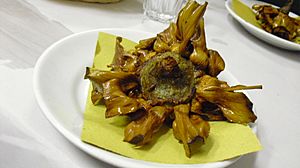
Jewish cuisines vary a lot depending on where they come from. They are usually grouped into Sephardi (from Spain, Portugal, and North Africa), Mizrahi (from the Middle East and Central Asia), and Ashkenazi (from Eastern and Central Europe).
However, there's a lot of overlap between these cuisines. This is because Jews often moved long distances, and different regions where Jews settled (like Southeastern Europe) were influenced by various cultures over time. For example, Balkan Jewish food has both Ashkenazi/European and Sephardic-Turkish influences, as this part of Europe was once part of the Ottoman Empire.
Since many Ashkenazi Jews moved to Palestine in the 1800s and the State of Israel was created, there's been more contact between Ashkenazi, Sephardi, and Mizrahi Jews. This has made Middle Eastern and Mediterranean food more important among Jews of all backgrounds.
Ashkenazi Cuisine
Today, Ashkenazi cuisine is mostly known through American-Jewish and Ashkenazi-Israeli food. But much of its cooking tradition comes from Central and Eastern Europe.
After being forced out of Western Europe in the Middle Ages, Jews often lived in poverty. This limited their ingredients. Dishes were made with fewer items, not heavily spiced, and flavorful ingredients had to be used sparingly. This is why some Ashkenazi dishes are known for being milder than Sephardic or Mizrahi dishes.
The cuisine uses ingredients that were affordable for the often poor Ashkenazi Jewish communities in Europe. These were ingredients readily available in Europe, often seen as less desirable by their non-Jewish neighbors, such as brisket, chicken liver, and artichokes.
Because Ashkenazi Jews were typically not allowed to grow crops in their home countries in Europe, their food has fewer vegetable-focused dishes compared to Sephardi and Mizrahi cuisines.
Meat is ritually slaughtered using the shechita process, then soaked and salted. Meat dishes are a big part of Shabbat, festival, and celebration meals. Braised meats like brisket are common, as are root vegetables like potatoes, carrots, and parsnips. These are used in dishes like latkes, matzo ball soup, and tzimmes.
Cooked, stuffed, and baked vegetables like stuffed cabbage are central to the cuisine. Since olive oil and other traditional Jewish fats were not easily available, fat from leftover chicken and goose skins (gribenes), called schmaltz, is traditionally used in fleishig (meat) dishes. Butter is traditionally used in milchig (dairy) dishes.
Fish Dishes
Since kosher meat wasn't always available, fish became a very important part of the Jewish diet. In Eastern Europe, it was sometimes saved especially for Shabbat. Fish is not considered meat in the same way as beef or poultry, so it can be eaten with dairy products. However, some Sephardim do not mix fish and dairy.
Even though fish is parve (neither meat nor dairy), Orthodox Jews will eat them in separate courses and wash dishes in between if served at the same meal. Gefilte fish and lox (smoked salmon) are popular in Ashkenazi cooking.
Gefilte fish (from German, meaning "stuffed fish") was traditionally made by skinning fish steaks, usually German carp. The flesh was de-boned, minced, and sometimes mixed with finely chopped browned onions, eggs, salt or pepper, and vegetable oil. The fish skin and head were then stuffed with this mixture and poached. The religious reason for a boneless fish dish on Sabbath is that Jewish law forbids separating bones from food while eating.
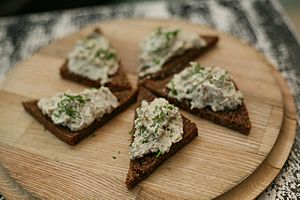
Today, a common store-bought product is "Polish" gefilte fish patties or balls. These are like quenelles, where sugar is added to the broth, giving them a slightly sweet taste. These are just the fish filling, not the whole stuffed fish. This way of serving came from the tradition of taking the stuffing out of the skin, instead of cutting the whole fish into slices.
While traditionally made with carp or whitefish and sometimes pike, gefilte fish can also be made from any large fish like cod, haddock, or hake in the United Kingdom.
The combination of smoked salmon or whitefish with bagels and cream cheese is a classic breakfast or brunch in American Jewish cuisine. It became famous at New York City delicatessens.
Vorschmack or gehakte hering (chopped herring) is a popular appetizer for Shabbat. It's made by chopping skinned, boned herring with hard-boiled eggs, sometimes onions, apples, sugar or pepper, and a little vinegar.
Soups
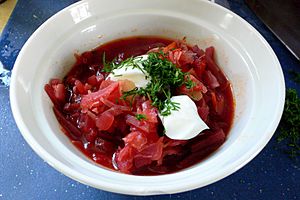
Many soups are typical of Ashkenazi cooking. One of the most common is chicken soup, traditionally served on Shabbat, holidays, and special occasions.
The soup might be served with noodles (lokshen in Yiddish). It's often served with shkedei marak (literally "soup almonds," popular croutons in Israel), called mandlen or mandlach in Yiddish. Other popular additions are kreplach (dumplings) and matza balls (kneidlach). These are made from matza meal, eggs, water, and pepper or salt. Some people save kneidlach for Passover and kreplach for other special occasions.
Some soups are made without meat or fat. These "soup with nothing" (soup mit nisht in Yiddish) were often the food of poorer people.
Soups like borsht were a basic food in Russia. Soups like krupnik were made of barley, potatoes, and fat. This was the main food for poor students in yeshivot (religious schools). In richer families, meat was added to this soup.
At weddings, "golden" chicken soup was often served. It probably got its name from the yellow circles of melted chicken fat floating on top. Today, chicken soup is jokingly called "Jewish penicillin" and is thought to help with the common cold.
There are several sour soups in the borscht family. One is kraut or cabbage borscht, made by cooking cabbage, meat, bones, onions, raisins, sour salt (citric acid), sugar, and sometimes tomatoes.
Beet borsht can be served hot or cold. In the cold version, a beaten egg yolk can be added before serving, and each bowl is topped with a dollop of sour cream. This last step is called farweissen (to make white).
Bread and Cake
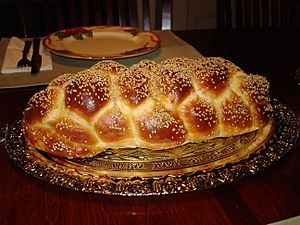
The dough for challah (called barkhes in Western Yiddish) is often shaped into forms with special meanings. For example, on Rosh Hashanah, it's shaped into rings and coins, meaning "May the new year be as round and complete as these." For Hosha'na Rabbah, bread is baked in the shape of a key, meaning "May the door of heaven open to let in our prayers."
The hamentash, a triangular cookie or turnover filled with fruit preserves (lekvar) or honey and black poppy seed paste, is eaten on the Feast of Purim. It's said to be shaped like the ears of Haman, the villain in the Purim story. The mohn kihel is a round or rectangular wafer sprinkled with poppy seeds. Pirushkes, or turnovers, are small cakes fried in honey or dipped in molasses after baking. Strudel is served for dessert. Kugels are prepared from rice, noodles, or mashed potatoes.
In Eastern Europe, Jews baked black (proster, or "ordinary") bread, white bread, and challah. The most common shape is the twist (koilitch or kidke). The koilitch is oval and about one and a half feet long. For special occasions like weddings, the koilitch can be about two and a half feet long.
The bagel, which started in Poland, is a popular Ashkenazi food and became very common in the United States.
Meat and Fats
Gebratenes (roasted meat), chopped meat, and essig-fleisch (vinegar meat) are favorite meat recipes. The essig or honig or sauerbraten is made by adding sugar, bay leaves, pepper, raisins, salt, and a little vinegar to partially roasted meat. Knish is a snack food with a meat or potato filling covered with dough, either baked or grilled.
A popular dish among Ashkenazim, like most Eastern Europeans, is pierogi (which are similar to but different from kreplach), often filled with minced beef. Kishka is a popular Ashkenazi dish traditionally made from a stuffing of flour or matza meal, schmaltz, and spices.
The rendered fat of chickens, known as schmaltz, is sometimes kept ready for cooking. Gribenes or "scraps," also called griven, are the crispy bits left from rendering the fat. They were a favorite food in Eastern Europe. Schmaltz is also eaten spread on bread.
A spread of chopped liver, prepared with onions and often including gribenes, is a popular appetizer, side dish, or snack, especially among Jews on the eastern coast of North America. It's usually served with rye bread or crackers. Brisket is also a popular Ashkenazi dish of braised beef brisket.
Holishkes, or stuffed cabbage rolls, are another European Jewish dish that came from poorer times for Jews. Because a live cow was more valuable than eating its meat in the Middle Ages, Jews used fillers like breadcrumbs and vegetables to mix with ground beef. This made it seem like more meat was stuffed into the cabbage leaves.
Sweets and Desserts
Teiglach, traditionally served on Rosh Hashanah, the Jewish New Year, are small balls of dough (about the size of a marble) soaked in a honey syrup. Ingberlach are ginger candies shaped into small sticks or rectangles.
In Europe, jellies and preserves made from fruit juice were used as pastry filling or served with tea. Among the poor, jelly was saved for sick people.
Flodni, a layered sweet pastry with apples, walnuts, currants, and poppy seeds, was a staple in Hungarian Jewish bakeries before World War II.
Because it was easy to prepare, made from cheap ingredients, and contained no dairy, compote became a common dessert in Jewish homes across Europe and was considered part of Jewish cuisine.
Side Dishes
Tzimmes usually consists of cooked vegetables or fruits, sometimes with meat added. The most popular vegetable is the carrot (mehren tzimmes), which is sliced. Turnips were also used for tzimmes, especially in Lithuania. In southern Russia, Galicia, and Romania, tzimmes was made of pears, apples, figs, prunes, or plums (floymn tzimmes).
Kreplach, similar to Russian pelmeni, are ravioli-like dumplings. They are made from flour and eggs mixed into dough, rolled into sheets, cut into squares, and then filled with finely chopped, seasoned meat or cheese. They are most often served in soup but can be fried. Kreplech are eaten on various holidays, including Purim and Hosha'na Rabbah.
Sephardi, Mizrahi, and Italian Jewish Cooking
It can be hard to tell the exact difference between traditional Sephardic and Mizrahi cuisines. This is because Sephardi Jews moved around and met Mizrahi Jews.
Generally, both cuisines reflect the food of the non-Jewish people they lived among. The need to keep kashrut rules leads to some important changes. For example, using olive oil instead of animal fat is often seen as a Jewish legacy in an area, because olive oil can be eaten with milk, unlike animal fat.
However, Sephardic and Ashkenazic ideas of kosher differ. Perhaps the biggest difference is that rice, a major food for Sephardim, is considered kosher for Passover by them, but it's forbidden as kitniyot by most Ashkenazim.
Sephardi cuisine focuses on salads, stuffed vegetables and vine leaves, olive oil, lentils, fresh and dried fruits, herbs and nuts, and chickpeas. Meat dishes often use lamb or ground beef. Fresh lemon juice is added to many soups and sauces.
Many meat and rice dishes include dried fruits like apricots, prunes, and raisins. Pine nuts are used as a garnish. Mizrahi cuisine uses a lot of fresh ingredients, as people bought food from local markets.
Meat is ritually slaughtered using the shechita process, then soaked and salted. Meat dishes are a big part of Shabbat, festival, and celebration meals.
Cooked, stuffed, and baked vegetables are central to the cuisine, as are various kinds of beans, chickpeas, lentils, and bulgur (cracked wheat). Rice takes the place of potatoes.
Coming from the Mediterranean and "sunny" climates, Mizrahi cuisine is often light. It emphasizes salads, stuffed vegetables and vine leaves, olive oil, lentils, fresh and dried fruits, herbs and nuts, and chickpeas. Meat dishes often use lamb or ground beef. Fresh lemon juice is added to many soups and sauces.
Many meat and rice dishes include dried fruits like apricots, prunes, and raisins. Pine nuts are used as a garnish. Pomegranate juice is a basic ingredient in Persian Jewish cooking. Kubbeh, a meat-stuffed bulgur dumpling, is found in the cooking of many Mizrahi communities. It's served in its cooking broth, like a soup.

Sephardic cuisine is known for using many vegetables that were not available to the Ashkenazim in Europe. These include spinach, artichokes, pine nuts, and (more recently) squash.
The cooking style is mostly Middle Eastern, with strong influences from Spanish, Italian, and North African flavors. The most popular Sephardic and Mizrahi dishes include malawach, jachnun, sabich, mofletta, meorav yerushalmi, skhug, and amba. Mizrahi Jewish cuisine has many unique dishes eaten by Jews in Iraq, Eastern Turkey, Kurdistan, Iran, and Yemen.
Shabbat and Holiday Dishes
Shabbat Meals
Good food is an important part of the mitzvah (commandment) of oneg Shabbat ("enjoying Shabbat"). So, much of Jewish cooking is centered around Shabbat.
Since observant Jews do not cook on Shabbat, special ways were developed to have a hot meal on Shabbat day.
One such dish is cholent or chamin. This is a slow-cooked meat stew with many variations. The ingredients are put in a pot and brought to a boil before lighting the candles on Friday evening. Then the pot is placed on a hotplate, a traditional blech (a thin metal sheet over the flames), or in a slow oven. It's left to simmer until the next day.
Cholent started in ancient Judea, possibly as far back as the Second Temple period. Over centuries, as Jewish communities spread, they created their own versions of the dish based on the local climate and ingredients.
A main feature of Shabbat cooking is the twisted bread, known as challot or (in parts of Germany, Austria, and Hungary) "barches." They are often covered with seeds to represent manna, which fell in a double portion on the sixth day.
Another Shabbat dish is calf's foot jelly, called p'tsha or šaltiena in Lithuania. In Poland, it's called galarita, galer, galleh, or fisnoge. Beef or calf bones are boiled with water, seasonings, garlic, and onions for a long time. Then it's cooled. The broth turns into a semi-solid mass, which is served in cubes.
Drelies, a similar dish from south Russia and Galicia, is mixed with soft-boiled eggs and vinegar when taken from the oven and served hot. In Romania, it's called piftie, and in Serbia pihtije. It's served cold with garlic, hard-boiled eggs, and vinegar sauce or mustard cream. It's a traditional winter dish.
Kugel is another Shabbat favorite, especially lokshen kugel, a sweet baked noodle pudding, often with raisins and and spices. Non-sweet kugels can be made of potatoes, carrots, or a mix of vegetables.
Traditional noodles—lokshen—are made from a dough of flour and eggs, rolled into sheets, and then cut into long strips. If the dough is cut into small squares, it becomes farfel. Both lokshen and farfel are usually boiled and served with soup.
Rosh Hashanah: Sweet New Year Foods
On Rosh Hashanah, the Jewish New Year, several symbolic foods called simanim are prepared and eaten. Each has a special meaning. All ingredients in these dishes are kosher, meaning they follow the rules of kashrut.
Most of these dishes are sweetened to represent a prayer for a sweet (pleasant) new year. Sweet dishes include apples that are either baked or covered in honey, lekach (honey cake), and makroudh (a pastry filled with dates and covered in honey).
Dates, symbolizing an end, can also be eaten alone to wish for enemies to meet their end. Dates were very valuable in biblical times, mentioned many times in the Bible and important as an export.
Pomegranate seeds are eaten for a year of many blessings, because there are many seeds inside a single pomegranate. It's thought there are 613 seeds, each representing one of the Torah's 613 commandments.
Challah bread is baked into a round, circular shape. This represents the cycle of life and a crown. It's also sweetened with honey or cinnamon and sugar instead of being dipped in the usual kosher salt.
Tzimmes, a side dish traditionally made of sweetened carrots or yams, is served to symbolize prosperity. This is because the Yiddish word meren means both "to multiply" and "carrot."
Other symbolic foods include:
- Teiglach, knotted pastries boiled in a honeyed syrup (for Ashkenazi Jews).
- The head of a fish or a ram, for a successful year where we are the "head," not the "tail" (because Rosh Hashanah starts the year).
- Fried leek cutlets, called karteh (for Sephardic Jews).
- Fried chard cutlets, called salkeh (for Sephardic Jews).
- A local type of zucchini called qara'a, made into sweet confiture (for Sephardic Jews).
- Algerian Jews serve a honey-dipped date pastry called makroudh.
Yom Kippur: A Fast Day
Yom Kippur is a fast day. The meal before the fast, called seuda hamafseket, usually has foods that digest slowly and are not very spicy. This helps make fasting easier and prevents thirst.
Sukkot: Eating in a Sukkah
On Sukkot, meals are eaten outside in a sukkah, a special hut built for the holiday. Fresh fruits are often eaten too, and they are woven into the roof of the hut.
Hanukkah: Fried Delights
It's a tradition to eat foods fried in oil to celebrate Hanukkah. Eating dairy products was a custom in medieval times.
- Latkes—potato pancakes, often topped with sour cream or applesauce (Ashkenazi food).
- Sufganiyot—jam doughnuts (Ashkenazi, popular in Israel).
- Fried doughnuts with powdered sugar sprinkled on top, called sfinge (mainly by North African Jews) or zalabiyeh.
- Rugelach—filled pastry.
Purim: Festive Treats
- Hamantaschen—triangular pastries traditionally filled with poppy seeds or prunes.
- Couscous—a Berber dish of small steamed balls of crushed durum wheat semolina, traditionally served with a stew on top.
- Fazuelos—Sephardic pastries of thin fried dough.
- Ma'amoul—shortbread pastries filled with dates or nuts.
Passover: No Leaven
Passover celebrates The Exodus from Egypt. It's said that the Jewish people left so quickly that their bread didn't have time to rise. To remember this, Jews eat matza (unleavened bread) and avoid bread, cakes, and other foods made with yeast or leavening agents. Today, rabbis allow the use of chemical leavening like baking powder.
Matza is a main food during the holiday and is used in many Passover dishes. Kneidlach (matza ball) soup is traditional. Fish is coated with matza meal before frying. Cakes and puddings are made with potato starch and matza meal.
Jewish cooks use both matza meal and potato starch for pastries during Passover. Beaten whole eggs or egg whites are often used to make pastries without leavening agents, like angel and sponge cakes (potato starch replaces cake flour) and coconut and almond macaroons.
Passover foods are quite different between Sephardic and Ashkenazic communities. Ashkenazim do not eat rice, while Sephardim do. Matza is traditionally made only from water and flour, but there are other kinds, like egg matza, which can also have fruit juice.
At the seder, some communities, especially very Orthodox Jews, traditionally use handmade shmura matza. This matza has been watched very carefully to ensure it follows strict kashrut rules.
Not having leaven in the home has made Jewish cooks very creative. They make a wide variety of Passover dishes using matza meal and potato as thickeners. Potato flour is widely used in cakes, along with finely ground matza meal and nuts.

Popular Ashkenazi dishes are matza brei (crumbled matza with grated onion, fried with scrambled egg), matza latkes (pancakes), and chremslach (also called crimsel or gresjelies, matza meal fritters). Wine-flavored matza kugels (pudding) have become part of modern Jewish cooking.
For thickening soups and sauces at Passover, fine matza meal or potato flour is used instead of regular flour. For frying fish or cutlets, a coating of matza meal and egg is used. For stuffing potatoes, soaked bread is replaced with matza meal.
"Noodles" can be made by making pancakes with beaten eggs and matza meal. When cooked, these are rolled up and cut into strips. They can be added to soup before serving. Matza kleys (dumplings) are small balls made from suet mixed with chopped fried onions, chopped parsley, beaten egg, and seasonings. They are dropped into soup and cooked.
Wine is also an important part of Passover meals. Traditionally, a Passover seder includes four cups of wine or grape juice, drunk during different parts of the seder. Kosher wine is usually consumed for Passover.
Shavuot: Dairy Delights
Dairy foods are traditionally eaten on Shavuot.
Tisha B'Av: A Day of Mourning
Tisha B'av is a fast day. It's preceded by nine days when Jews traditionally don't eat meat, except on Shabbat. So, dairy and vegetarian dishes are prepared during this time.
The meal before the fast (the seudat mafseket) also consists of dairy foods. It usually includes dishes made from lentils and eggs, which are ancient Jewish symbols of mourning. Some Ashkenazi Jews eat hard-boiled eggs sprinkled with ashes to symbolize mourning.
See also
 In Spanish: Gastronomía judía para niños
In Spanish: Gastronomía judía para niños



